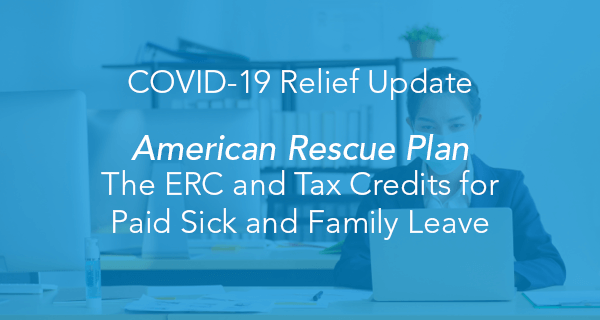The latest COVID-19 relief package, dubbed the American Rescue Plan Act of 2021 (Rescue Plan), extends two payroll tax credits created nearly a year ago to help businesses weather the pandemic. The employee retention credit (ERC), designed to encourage businesses to keep employees on their payroll despite experiencing economic hardship, was set to expire July 1. The Rescue Plan extends the ERC through December 31, 2021. The paid sick and family leave tax credits, available to employers providing paid leave to employees for various COVID-19 related reasons, were scheduled to expire March 31. The Rescue Plan extends the credits through September 30, 2021.
In addition to extending the expiration dates, the Rescue Plan makes several changes to these programs. We break down the major changes below, beginning with the ERC.
The ERC
Background
The ERC is a refundable payroll tax credit for eligible employers, calculated as a percentage of qualified wages paid to employees. As created by the CARES Act, the ERC applied to wages paid from March 13, 2020 through December 31, 2020 (the 2020 ERC). The Consolidated Appropriations Act, 2021 (Appropriations Act) extended the ERC into the first and second quarters of 2021 (the 2021 ERC).
The 2021 ERC is equal to 70% of qualified wages paid to employees, up to a maximum of $10,000 in wages per employee each quarter. To be eligible, a business must meet one of two criteria during the calendar quarter:
- The operation of the business is fully or partially suspended due to orders from an appropriate governmental authority limiting commerce, travel, or group meetings because of COVID-19; or
- The employer experiences a significant decline in gross receipts.
For purposes of the 2021 ERC, an employer experiences a significant decline in gross receipts if its gross receipts for the relevant calendar quarter in 2021 are less than 80% of its gross receipts for the same calendar quarter in 2019. An employer also can elect to determine eligibility by comparing its gross receipts for the immediately preceding calendar quarter to the corresponding 2019 calendar quarter.
The definition of qualified wages for the 2021 ERC is more restrictive for employers that averaged more than 500 full-time employees during 2019 (large employers). For large employers, qualified wages include only wages paid when the employee is not providing services.
For additional background on the 2020 and 2021 ERC, click the button below:
The Rescue Plan’s Changes
The Rescue Plan extends the ERC through December 31, 2021, and restructures the credit to be claimed against the employer’s share of Medicare rather than Social Security taxes.
It also expands eligibility for the credit to “recovery startup businesses.” A recovery startup business is any employer that began carrying on any trade or business after February 15, 2020. Guidance on additional eligibility requirements is expected. The credit allowed for recovery startup businesses for any calendar quarter cannot exceed $50,000.
In addition, the Rescue Plan expands the definition of qualified wages for large employers that qualify as “severely financially distressed employers.” A severely financially distressed employer is an eligible employer whose gross receipts for the relevant calendar quarter in 2021 are less than 10% of its gross receipts for the same calendar quarter in 2019. Severely financially distressed employers can count all wages paid to employees as qualified wages rather than only wages paid to employees when they do not provide services.
The Rescue Plan states that wages used in connection with a Paycheck Protection Program (PPP) loan, a Shuttered Venue Operator Grant (SVOG), or a Restaurant Revitalization Grant (RRG) cannot be used for calculating the 2021 ERC.
The Rescue Plan’s changes apply to wages paid during the third and fourth quarters of 2021.
Tax Credits for Paid Sick and Family Leave
Background
The Families First Coronavirus Response Act (FFCRA), enacted in March of 2020, required most government employers, as well as tax-exempt organizations and private employers with fewer than 500 employees, to provide employees with paid sick or family leave for various COVID-19 related reasons. Under the FFCRA, the amount of leave and pay to which employees were entitled varied depending on the reason for leave.
To offset the cost of providing paid leave, the FFCRA provided employers with a refundable payroll tax credit equal to 100% of qualified sick and family leave wages, plus allocable health plan expenses and the employer’s share of Medicare tax paid each calendar quarter. The credit was allowed against the employer portion of Social Security tax. Equivalent credits were available for self-employed individuals.
Under the FFCRA, the requirement to provide paid leave took effect April 1, 2020, and expired December 31, 2020. However, the Appropriations Act extended the payroll tax credits’ availability to cover leave taken through and including March 31, 2021. Notably, the Appropriations Act did not extend the requirement to provide FFCRA paid leave beyond December 31, 2020; it only extended the availability of the payroll tax credits for employers that voluntarily provide this leave to eligible employees.
For additional background on the FFCRA paid sick and family leave tax credits, click the button below:
Additional FFCRA Paid Sick and Family Leave Background
The Rescue Plan’s Changes
The Rescue Plan extends the employer payroll tax credits, but not the requirement to provide paid leave, for sick and family leave taken through and including September 30, 2021. In addition, the Rescue Plan:
- Resets the 10-day limit for sick leave beginning April 1, 2021 (the FFCRA limited sick leave to 10 days per employee);
- Allows sick and family leave tax credits for leave provided to employees to obtain a COVID-19 vaccine or recover from an injury, disability, illness, or condition related to the vaccine;
- Expands the definition of paid family leave to allow family leave tax credits to be claimed for all qualifying uses of paid sick leave;
- Increases the limit on the tax credit for paid family leave wages to $12,000 (up from $10,000) total per employee;
- Adds a non-discrimination rule prohibiting employers from claiming the tax credits if paid leave provided to employees discriminates in favor of highly compensated or full-time employees or based on employment tenure;
- Restructures the tax credits to be claimed against the employer’s share of Medicare tax, rather than Social Security tax, after March 31, 2021; and
- Permits 501(c)(1) government organizations and certain state and local governments to claim the tax credits.
Under the Rescue Plan, wages used in connection with a PPP loan, an SVOG, or an RRG cannot be used for claiming sick or family leave tax credits.
Self-employed individuals are allowed a refundable income tax credit for paid sick and family leave. The Rescue Plan extends and expands the sick and family leave tax credits for self-employed individuals, similar to the modifications made for employers.
For more information on COVID-19 relief efforts, visit our coronavirus relief resources page or browse the articles below:
Do you have questions about the new American Rescue Plan Act? Contact your Dean Dorton advisor, or contact us at:
covid19solutions@deandorton.com
Related Articles








